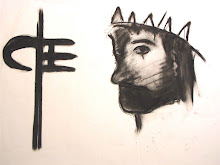The Mirror Stage
 According to Lacan, when
the infant recognizes herself in a mirror, she is suddenly confronted with an
image of herself – whereas she previously experienced existence in fragments
intersected with libidinal needs -- the wholeness in the image lends itself to
the seeking-wholeness looking at itself -- what the child sees in the mirror Lacan
calls the "Ideal-I" (Lacan, Mirror
Stage, 2). This ego ideal provides an image of wholeness which constitutes the ego. Like Freud Lacan
thinks the ego is formed through an external force; in this case, the sudden
realization of a complete image of the self that appears in the mirror; which
counteracts an infant’s primordial sense of her fragmented body.
According to Lacan, when
the infant recognizes herself in a mirror, she is suddenly confronted with an
image of herself – whereas she previously experienced existence in fragments
intersected with libidinal needs -- the wholeness in the image lends itself to
the seeking-wholeness looking at itself -- what the child sees in the mirror Lacan
calls the "Ideal-I" (Lacan, Mirror
Stage, 2). This ego ideal provides an image of wholeness which constitutes the ego. Like Freud Lacan
thinks the ego is formed through an external force; in this case, the sudden
realization of a complete image of the self that appears in the mirror; which
counteracts an infant’s primordial sense of her fragmented body.
Words that Lacan
associates with this event are: jubilant, specular image, mirror stage, -- still sunk in his motor incapacity,
nursing, dependency -- the I is precipitated in a primordial form before it is ‘objectified’
in the dialectic of identification with the other.
This image in the mirror
is the image of coherence – of what makes the world and our place as complete
subjects in it make sense -- the image has a framing, forming power. Internal
self is drawn to external image -- internal ‘self-identifies’ via external. The
mirror stage is the infant’s first encounter with subjectivity. It reorients spatial relations. It congeals an external sense of coherence,
and with a sense of "I" and "You."
Lacan’s Three Orders
The three orders are the
fundamental dimensions of psychical subjectivity -- they are spaces in which
aspects of subjectivity are operating -- this is a way of situating the subject
within a system of perception and a dialogue with the external world -- they
are sites of trying-to-be -- these are the battlefields in which the subject struggles
for its identity -- at first the most important part of the message here is
that the thing we are struggling with in order to be is cultural -- but with a
deeper look we see that Lacan is very aware that there are biological instincts
and material realities --
The Imaginary
The imaginary becomes the
internalized image of this ideal, whole self and is situated around the tension
between coherence versus fragmentation. The imaginary can roughly be aligned
with the formation of the ego -- which serves as the mediator between the internal
and the external world -- it creates new potential-spaces
With his choice of the
word “imaginary,” Lacan intends to designate that which is fictional,
simulated, virtual, fantasy. However, the phenomena of the imaginary are
necessary -- these are basic fantasies -- transcendental apperception -- also
in Kantian terms, phainomenon
The imaginary as the ego ---- I, adult, reality-principle
In Sanskrit
-- atman
The Symbolic
The symbolic is the
formation of marks, signifiers and language -- thus it is considered to be the
"determining order of the subject" -- the subject exits the alienated
body and migrates to the logos.
"Symbols envelop the
life of man in a network so total that they join together, before he comes into
the world, those who are going to engender him…"
"The human being
speaks but does so because the symbol has made this thing human.”
The symbolic order
functions as the way in which the subject is organized and, to a certain
extent, how the psyche becomes accessible. It is associated with language, with
words, with writing and can be aligned with Peirce’s “symbol” and Saussure’s
“signifier.”
The symbolic register
refers to the customs, institutions, laws, mores, norms, practices, rituals,
rules, traditions -- the stuff of society -- Lacan's phrase “symbolic order,”
which encompasses all of the preceding, can be understood as roughly equivalent
to what Hegel designates as “objective spirit” -- the non-natural universe as
an elaborate set of inter-subjective and trans-subjective contexts into which
individual human beings are thrown at birth (Heidegger’s Geworfenheit), a pre-existing order preparing places for human
beings in advance and influencing the vicissitudes of their ensuing lives.
The symbolic as the conscience ---- culture, superego, repression, parent
In Sanskrit
-- dharma (duty)
The Real
The real is that which
resists representation, whatever is pre-mirror, pre-imaginary, and
pre-symbolic …
what loses its ‘reality’
once it is imagined (seen as a ploy for wholeness) or symbolized (made
conscious through language).
It is “the aspect where
images and words fail.”
Words that Lacan
associates with the real: ineliminable,
foreclosed, approached but never grasped, umbilical cord … the real is
everything that is not invented -- not media,
but instead everything that informs media -- the real behind the endless
cultural hyperreality.
The real is that which is
foreign to Imaginary-Symbolic framing and remains elusive, resisting by nature
capture in any comprehensibly meaningful formulations of concatenations of
Imaginary-Symbolic signs. It is a
transcendence troubling and thwarting Imaginary-Symbolic imaging and speaking from without -- as well as an immanence perturbing and subverting whatever is imaged or spoken from within -- it is restless
It comes to be associated
with libido, matter, contingency and traumatic events, unbearable bodily
intensities, anxiety, and death. It is
the hypokeimenon.
The real as the Id ---- child, instinct, wanting, needing -- pleasure principle --
in Sanskrit,
tanha (thirst)

No comments:
Post a Comment